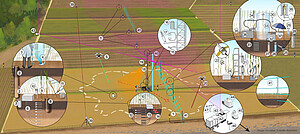To advance the understanding of Land-Atmosphere processes and the resulting local and non-local feedbacks, observations in all compartments of the L-A System with high vertical and horizontal resolutions need to be combined. For this purpose, the instrumentation at the Land-Atmosphere Feedback Observatory (LAFO) will be expanded by a sophisticated sensor synergy which will address all objectives of LAFI. This requires a joint operation of scanning lidar systems, FODS, UAVs, and in-situ sensors for observing (partitioning) ET and many other soil, plant and atmospheric quantities. The vertical and horizontal structures of key variables in the L-A system will be observed simultaneously to capture the influence of land surface heterogeneities, such as micro- to mesoscale circulations, on L-A feedbacks.
The envisioned experimental design is depicted in Fig. 1. The observations will be performed within a General Operations Period (GOP) into which a series of five Intensive Observations Periods (IOPs) are embedded. During the GOP (2nd LAFI year), the operational instrumentation will run during a full vegetation period (early spring till late autumn).

Fig. 1: Overview of LAFO.
The majority of the measurements will focus on four plots, where maize and winter wheat are grown (fields 1 and 2 on Fig. 2), to study two of the most important crops in Europe and the land surface heterogeneities induced by agricultural land use. Spaceborne remote sensing will complement these observations by providing information on heterogeneity of soil and land cover over a larger domain.

Fig. 2: Experimenatal design of the LAFO GOP and IOPs.
The five IOPs will take place in five critical phenological periods, during which the entire LAFI sensor synergy will be employed: (1) stem elongation (BBCH 30-39) of wheat with maximum water demand in April; (2) booting (BBCH 40-49) of wheat in May; (3) flowering (BBCH 60-69) of wheat and beginning leaf development (BBCH 10-19) of maize in June; (4) ripening (BBCH 80-89) of wheat and continued leaf development of maize in July; (5) flowering of maize with maximum water demand in August. The exact IOP times and lengths will be kept flexible and governed by observed meteorological conditions and vegetation development.
Furthermore, to enhance our understanding of fluxes at the land surface and their profile in the ABL including entrainment, and the statistical analysis of extreme events, the long-term measurements of the Meteorological Observatory Lindenberg - Richard Aßmann Observatory (MOL-RAO) are analyzed.